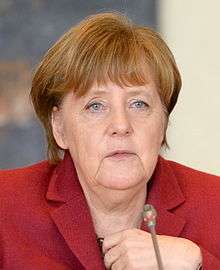German order of precedence
The German order of precedence is a symbolic hierarchy of the five highest federal offices in Germany used to direct protocol. It has no official status, but has been established in practical use.[1]
- The President of Germany, the head of state of Germany.
- The President of the Bundestag, the speaker of the German parliament, the Bundestag.
- The Chancellor of Germany, the head of the government of Germany.
- (1.) The President of the Bundesrat, the speaker of the Bundesrat, a federal legislative chamber, in which the governments of the sixteen german states are represented. He or she is ex officio also deputy to the President of Germany (Basic Law, Article 57). Thus, he or she becomes first in the order, while acting on behalf of the President or while acting as head of state during a vacancy of the presidency.
- The President of the Federal Constitutional Court, the supreme court of Germany.
Current office-holders
| No. | Office | Image | Incumbent | in office since | deputie(s) |
|---|---|---|---|---|---|
| 1st |  12th President of Germany | .jpg) | Frank-Walter Steinmeier | 19 March 2017 | Michael Müller (President of the Bundesrat) |
| 2nd |  13th President of the Bundestag | _(cropped).jpg) | Wolfgang Schäuble | 24 October 2017 | Hans-Peter Friedrich Thomas Oppermann Wolfgang Kubicki Petra Pau Claudia Roth (Vice Presidents of the Bundestag) |
| 3rd |  8th Chancellor of Germany |  | Angela Merkel | 22 November 2005 | Olaf Scholz (Vice Chancellor of Germany) |
| 4th (1st) |  72nd President of the Bundesrat | _by_Sandro_Halank.jpg) | Michael Müller | 1 November 2017 | Malu Dreyer (First Vice President of the Bundesrat) Daniel Günther (Second Vice President of the Bundesrat) |
| 5th |  9th President of the Federal Constitutional Court | _by_Sandro_Halank.jpg) | Andreas Voßkuhle | 16 March 2010 | Ferdinand Kirchhof (Vice President of the Federal Constitutional Court) |
Living former office-holders
The order of precendence is also observed with respect to former office-holders in some cases, for example if they participate in official ceremonies as honoured guests.
- Horst Köhler, 9th President of Germany (2004-2010)
- Christian Wulff, 10th President of Germany (2010-2012)
- Joachim Gauck, 11th President of Germany (2012-2017)
- Rita Süssmuth, 10th President of the Bundestag (1988-1998)
- Wolfgang Thierse, 11th President of the Bundestag (1998-2005)
- Norbert Lammert, 12th President of the Bundestag (2005-2017)
- Gerhard Schröder, 7th Chancellor of Germany (1998-2005), 51st President of the Bundesrat (1997-1998)
- Bernhard Vogel, 28th and 40th President of the Bundesrat (1976-1977 and 1987-1988)
- Hans-Ulrich Klose, 31st President of the Bundesrat (1979-1980)
- Björn Engholm, 41st President of the Bundesrat (1988-1989)
- Walter Momper, 42nd President of the Bundesrat (1989-1990)
- Alfred Gomolka, 44th President of the Bundesrat (1991-1992)
- Berndt Seite, 45th President of the Bundesrat (1992)
- Oskar Lafontaine, 46th President of the Bundesrat (1992-1993)
- Klaus Wedemeier, 47th President of the Bundesrat (1993-1994)
- Edmund Stoiber, 49th President of the Bundesrat (1995-1996)
- Erwin Teufel, 50th President of the Bundesrat (1996-1997)
- Hans Eichel, 52nd President of the Bundesrat (1998-1999)
- Roland Koch, 53rd President of the Bundesrat (1999)
- Kurt Biedenkopf, 54th President of the Bundesrat (1999-2000)
- Kurt Beck, 55th President of the Bundesrat (2000-2001)
- Klaus Wowereit, 56th President of the Bundesrat (2001-2002)
- Wolfgang Böhmer, 57th President of the Bundesrat (2002-2003)
- Dieter Althaus, 58th President of the Bundesrat (2003-2004)
- Matthias Platzeck, 59th President of the Bundesrat (2004-2005)
- Peter Harry Carstensen, 60th President of the Bundesrat (2005-2006)
- Harald Ringstorff, 61st President of the Bundesrat (2006-2007)
- Ole von Beust, 62nd President of the Bundesrat (2007-2008)
- Peter Müller, 63rd President of the Bundesrat (2008-2009)
- Jens Böhrnsen, 64th President of the Bundesrat (2009-2010)
- Hannelore Kraft, 65th President of the Bundesrat (2010-2011)
- Horst Seehofer, 66th President of the Bundesrat (2011-2012)
- Winfried Kretschmann, 67th President of the Bundesrat (2012-2013)
- Stephan Weil, 68th President of the Bundesrat (2013-2014)
- Volker Bouffier, 69th President of the Bundesrat (2014-2015)
- Stanislaw Tillich, 70th President of the Bundesrat (2015-2016)
- Malu Dreyer, 71st President of the Bundesrat (2016-2017)
- Hans-Jürgen Papier, 8th President of the Federal Constitutional Court (2002-2010)
Trivia
As of June 2018, 102 persons have held at least one of the five highest german federal offices. Six of them were female:
- Annemarie Renger, 5th President of the Bundestag (1972-1976)
- Rita Süssmuth, 10th President of the Bundestag (1988-1998)
- Angela Merkel, 8th Chancellor of Germany (incumbent since 2005)
- Hannelore Kraft, 65th President of the Bundesrat (2010-2011)
- Malu Dreyer, 71st President of the Bundesrat (2016-2017)
- Jutta Limbach, 7th President of the Federal Constitutional Court (1994-2002)
The following persons have held two different of these offices:
- Karl Carstens, 5th President of Germany (1979-1984), 6th President of the Bundestag (1976-1979)
- Roman Herzog, 7th President of Germany (1994-1999), 6th President of the Federal Constitutional Court (1987-1994)
- Johannes Rau, 8th President of Germany (1999-2004), 34th and 48th President of the Bundesrat (1982-1983 and 1994-1995)
- Kai-Uwe von Hassel, 4th President of the Bundestag (1969-1972), 7th President of the Bundesrat (1955-1956)
- Kurt-Georg Kiesinger, 3rd Chancellor of Germany (1966-1969), 14th President of the Bundesrat (1962-1963)
- Willy Brandt, 4th Chancellor of Germany (1969-1974), 9th President of the Bundesrat (1957-1958)
- Gerhard Schröder, 7th Chancellor of Germany (1998-2005), 51st President of the Bundesrat (1997-1998)
The following persons have held one of these offices two times (non consecutively):
- Hans Ehard, 2nd and 13th President of the Bundesrat (1950-1951 and 1961-1962)
- Georg-August Zinn, 5th and 16th President of the Bundesrat (1953-1954 and 1964-1965)
- Peter Altmeier, 6th and 17th President of the Bundesrat (1954-1955 and 1965-1966)
- Franz-Josef Röder, 11th and 21st President of the Bundesrat (1959-1960 and 1969-1970)
- Hans Koschnik, 22nd and 33rd President of the Bundesrat (1970-1971 and 1981-1982)
- Bernhard Vogel, 28th and 40th President of the Bundesrat (1976-1977 and 1987-1988)
- Johannes Rau, 34th and 48th President of the Bundesrat (1982-1983 and 1994-1995)
References
This article is issued from
Wikipedia.
The text is licensed under Creative Commons - Attribution - Sharealike.
Additional terms may apply for the media files.